Understanding the Great Permian Catastrophe: A Volcanic Disaster
Approximately 250 million years ago, Earth faced one of its most significant and catastrophic events, leading to the near-total annihilation of life. This disaster, known as the Permian-Triassic extinction event, is believed to have been fueled primarily by extensive volcanic activity, particularly the eruptions in what is now known as Siberia.
The Role of Volcanic Eruptions
During this period, immense volcanic eruptions released vast quantities of carbon dioxide (CO2) into the atmosphere, altering global climates drastically. These eruptions are part of what scientists term the Siberian Traps—a series of large igneous provinces characterized by extensive lava flows and explosive volcanic activity. The intense release of CO2 triggered severe warming of the Earth’s atmosphere, which in turn catalyzed long-lasting El Niño-like conditions, inciting further climatic chaos.
The Impact of El Niño on the Ecosystem
The extreme climate alterations led to a significant shift in habitats and ecosystems. As the Earth’s temperature soared, many species struggled to adapt. Most life forms had evolved to thrive within stable temperature ranges; the rapid rise in temperatures left many unable to survive. Although forests had the potential to sequester some of the excess CO2, the unprecedented heat ultimately led to their destruction, exacerbating the ecological crisis.
Mass Extinction: The Consequences
The consequences of these events were severe—approximately 90% of Earth’s species succumbed during this extinction episode. The loss was so profound that it took millions of years for ecosystems to recover and diversify again. The Permian-Triassic extinction is often regarded as Earth’s most significant extinction event, reshaping the trajectory of life on the planet.
Lessons for Today: Can It Happen Again?
Today, atmospheric CO2 concentrations have reached around 419 parts per million (ppm). While this is significantly lower than during the Permian period, experts caution that human activities—particularly the burning of fossil fuels and deforestation—are contributing to an accelerated increase in CO2 levels. This trend raises concerns about the potential for future climatic catastrophes, reminiscent of the past.
Key Takeaways for Future Sustainability
| Factor | Permian Period | Today |
|---|---|---|
| CO2 Levels | Significantly higher than 419 ppm | ~419 ppm |
| Impact of Climate Change | Widespread extinction | Potential for major disruptions in ecosystems |
| Human Role | N/A | Significant contributor to atmospheric changes |
Conclusion
The history of Earth’s climatic shifts serves as a stark reminder of the delicate balance within ecosystems. As we navigate the challenges posed by climate change today, it becomes increasingly essential to heed the lessons from the geological past. Understanding the events that led to past extinctions empowers us to work towards sustainable practices that can mitigate the impacts of our current activities on the planet.



